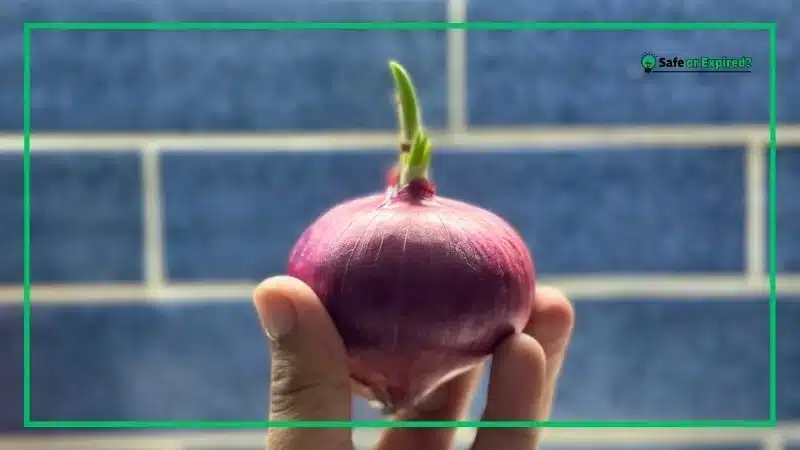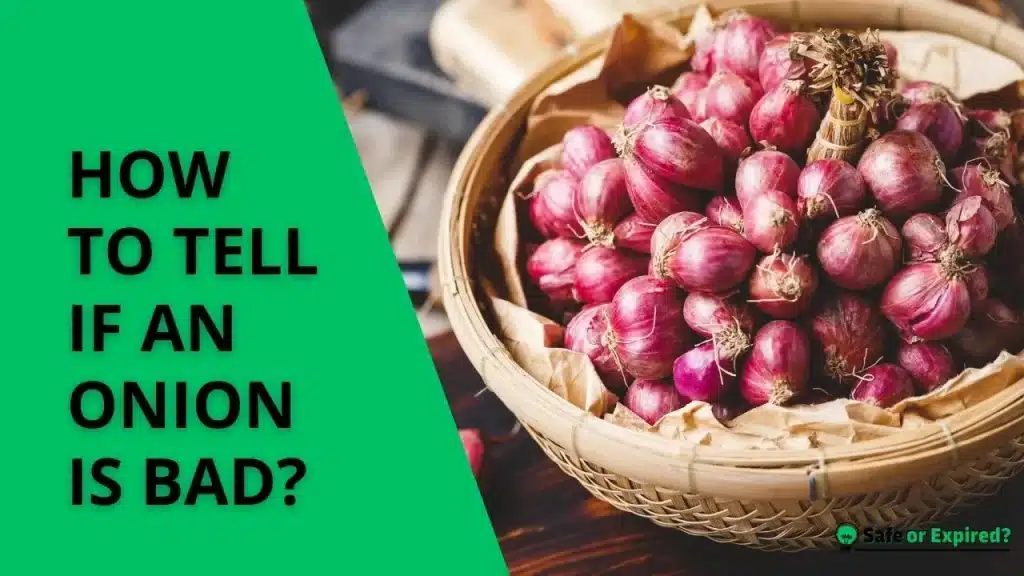“How to tell if an onion is bad?” is a common query for food safety enthusiasts. To know, look for signs like a soft texture, dark spots, or a sour smell. But are these signs the same when you chop the onions? Here, I’m discussing everything, along with what will happen if you eat spoiled onion.
How to Tell if an Onion Is Bad? 4 Telltale Signs
To tell if an onion is bad, look for signs like soft spots, mold, or sprouting. A bad onion may also have a slimy texture and an off or foul odor. Discoloration or an unusually strong, unpleasant smell are also indicators that the onion has gone bad and should be discarded.
Soft or Mushy Texture
A fresh onion should be firm to the touch. I picked up this one in the market and it was fresh:

However, if your onion feels soft, mushy, or has a slimy texture, it’s likely spoiled. This change in texture occurs because the onion’s cells break down over time, leading to a loss of firmness. When onions start to rot, bacteria and fungi can grow, making the texture unpleasant and unsafe to eat.
Dark Spots
Dark spots on an onion can indicate mold or decay. These spots often appear black, brown, or gray. Mold can develop when onions are stored in damp or humid conditions. If you notice dark spots, it means the onion has started to decompose.
It’s best to avoid using onions with dark spots because they can harbor harmful bacteria.
Sour or Off Smell
A fresh onion should have a mild, slightly sweet scent. If your onion smells sour, pungent, or just “off,” it’s one of the clear signs that it has gone bad. This bad smell is caused by the breakdown of the onion’s compounds, which releases sulfur compounds and other gases.
These odors indicate that the onion is no longer fresh and could be harmful if consumed.
Mold
Mold on an onion is a clear sign of spoilage. Mold can appear in various colors, including white, green, or black, and is usually fuzzy. It grows when onions are stored in moist conditions for too long. Mold not only affects the onion’s taste but also poses health risks if ingested. Always discard onions with visible mold to stay safe.
Ever wondered, “What does a bad onion taste like?” A bad onion typically has a very unpleasant taste. It can be bitter, sour, or have a strong, off-putting flavor that is significantly different from the mild, slightly sweet taste of a fresh onion. If an onion tastes unusually harsh or rancid, it is likely spoiled and should not be consumed.
Got your onions checked? Now, if you’re wondering about other members of the onion family, like green onions, learn about their shelf life in different forms in Green Onions Shelf Life: From Raw to Cooked – How Long Do They Last?
How To Tell if an Onion Is Bad in the Fridge? 4 Ways to Identify
To tell if an onion in the fridge is bad, check for signs like soft or mushy spots, mold, or a slimy texture. A bad onion may also emit a strong, unpleasant odor. Additionally, if the onion has sprouted excessively or has discolored, it should be discarded.
Mushy Texture
When you grab an onion from the fridge, it should feel firm. If it feels squishy or mushy, it’s probably gone bad. Fridges can be a bit too moist for onions, making them turn soft and icky. If your onion is mushy, it’s time to say goodbye and toss it out.
Sour Smell
A fresh onion has a light, almost sweet smell. But if your onion smells sour or just plain stinky, it’s a sure sign it’s spoiled. The fridge can sometimes speed up the growth of bacteria and mold, causing that nasty smell. So, if it doesn’t smell right, trust your nose and throw it away.
Wet Spots
Finding wet spots on your onion? That’s a bad sign. Fridges can make onions damp, leading to wet, mushy spots. These spots are usually where the onion is starting to rot. If you see wet spots, it’s best not to use that onion in your cooking.
Some of these onions have wet spots:

Excessive Sprouting or Discoloration
Have you noticed your onion sprouting green shoots or turning funny colors? When onions sprout, they’re using up their stored energy, which means they’re not so fresh anymore.
Discoloration, like yellow or brown patches, also means the onion is getting old. If your onion looks like it’s trying to grow a garden or changing colors, it’s time to toss it.
What Happens if You Eat Bad Onion? All You Need to Know
Eating a bad onion can lead to food poisoning, causing symptoms such as nausea, vomiting, stomach cramps, and diarrhea. In some cases, it may also result in dehydration or more severe gastrointestinal issues. If you experience these symptoms after consuming a bad onion, seek medical attention to manage the illness.
Stomach Pain
If you eat a bad onion, one of the first things you might feel is a stomach ache. Your belly could cramp up and feel very uncomfortable. This happens because spoiled onions can have harmful bacteria that upset your stomach. The pain might come and go, or it could stay for a while, making you feel pretty miserable.
Nausea
Nausea is that awful feeling where you feel like you’re going to throw up. Eating a bad onion can make you feel this way because of the bacteria and mold that might be present. This yucky feeling can make it hard to do anything and can last until the bad stuff is out of your system.
Vomiting
Sometimes, if you eat a bad onion, your body will try to get rid of it by making you throw up. Vomiting is the body’s way of saying, “Get this out of me!” It’s not fun, but it’s a way your body protects itself from harmful substances. Drinking plenty of fluids can help you feel better faster.
Diarrhea
Eating a spoiled onion can also cause diarrhea. This is when you have to go to the bathroom a lot, and your poop is very watery. Diarrhea happens because your body is trying to flush out the bad stuff quickly. It’s important to drink lots of water to stay hydrated if this happens to you.
By being aware of these side effects, you can understand why it’s so important to avoid eating bad onions and keep yourself feeling great.
So, if someone asks, “Can you eat a bad onion,” the answer is No.
How To Tell if Cut Onion Is Bad? 4 Clear Indicators
To tell if a cut onion is bad, look for signs like a slimy texture, an off or sour smell, discoloration (brown, black, or moldy spots), and a soft, mushy consistency. Fresh onions should be crisp and firm, with a sharp, pungent smell. Discard any onion exhibiting these signs.
Slimy Texture
A cut onion should feel crisp and firm. If it becomes slimy, this is a clear sign that it has gone bad. When onions are cut, they release moisture, and if stored improperly, this can lead to a slimy coating. This slime is a result of bacterial growth. If you touch a cut onion and it feels slippery or sticky, it’s time to throw it away.
Sour Smell
A fresh-cut onion should have a sharp, but not unpleasant, onion scent. If it starts to smell sour or off, it’s a sign that it’s spoiled. This change in smell is due to the growth of bacteria and mold on the onion. The sour odor indicates that the onion is decomposing and should not be used. Trust your nose; if it smells bad, it is bad.
Discoloration
When you cut an onion, it should have a clear, even color. If the onion starts to turn brown, yellow or has dark spots, it’s a sign of spoilage. Discoloration means that the onion is oxidizing and breaking down. This process can make the onion unsafe to eat. Always check the color of your cut onions before using them in your cooking.
Mold
Mold can develop on a cut onion, especially if it’s stored in a damp or poorly ventilated area. Mold appears as fuzzy patches and can be white, green, or black. It’s a definite sign that the onion has spoiled. Moldy onions should be discarded immediately, as they can cause health problems if consumed. Keep your cut onions dry and properly sealed to prevent mold growth.
Just like onions, other root condiments like horseradish also have a specific shelf life. Find out if you can still use it past its prime in Does Horseradish Expire? Here’s How to Tell.
How To Know if an Onion Is Bad on the Inside? Let’s Find Out
To determine if an onion is bad on the inside, cut it open and look for signs such as discoloration, including brown, black, or moldy spots, which indicate spoilage. A soft or mushy texture inside also suggests the onion is no longer fresh, as it should be firm.
Soft or Mushy Texture
When you cut into an onion, the inside should be firm and crisp. If the inside feels soft or mushy, it’s a sign that the onion has gone bad. This texture change happens when the onion starts to decompose. Bacteria and mold can cause the onion’s cells to break down, resulting in a soft, unpleasant texture. If you notice this, it’s best to throw the onion away.
Foul Smell
A fresh onion has a sharp, slightly sweet smell. If the inside of the onion smells sour, rotten, or just off, it’s a clear sign of spoilage. This bad odor is caused by the breakdown of the onion’s compounds, which releases unpleasant gases. If your onion smells bad when you cut into it, it’s no longer safe to eat and should be discarded.
Discoloration
When you cut into an onion, the inside should be a uniform white or light color, depending on the type of onion. If you see brown, yellow, or black spots inside the onion, it’s a sign of spoilage. These discolorations indicate that the onion is rotting or has mold growing inside. Discolored onions are not safe to eat and should be thrown away.
Hollow Center
Sometimes, onions can develop a hollow center. This happens when the onion grows too fast or is stored for a long time. While a hollow center is not always a sign of spoilage, it can indicate that the onion is starting to go bad. If the hollow part also has a foul smell, mold, or discoloration, it’s best to discard the onion.
If Part of an Onion Is Bad Can You Eat the Rest?
If part of an onion is bad, it’s best to discard the entire onion. While it might seem safe to cut away the bad part, bacteria, and mold can spread throughout the onion, even if it’s not visible. Eating any part of a spoiled onion can pose health risks. To stay safe, always use a fresh onion.
Conclusion
Remember these key points to tell if an onion is bad:
- A soft or mushy texture means the onion is spoiled.
- A sour or off smell indicates it’s no longer fresh.
- Dark or wet spots suggest the onion is rotting.
- Mold on the onion is a clear sign it’s gone bad.
- Excessive sprouting or discoloration means the onion is past its prime.
Keeping these tips in mind will help you ensure your onions are always fresh and your meals stay delicious and safe!

